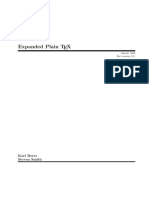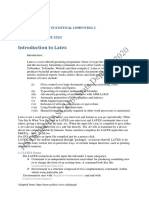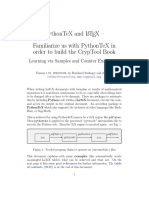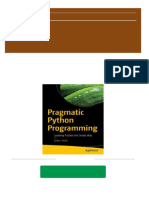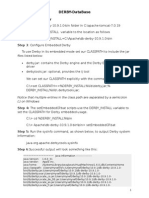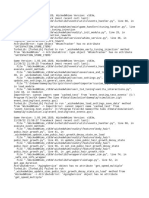TB 121 Ltnews 28
TB 121 Ltnews 28
Uploaded by
elian ulrichCopyright:
Available Formats
TB 121 Ltnews 28
TB 121 Ltnews 28
Uploaded by
elian ulrichOriginal Title
Copyright
Available Formats
Share this document
Did you find this document useful?
Is this content inappropriate?
Copyright:
Available Formats
TB 121 Ltnews 28
TB 121 Ltnews 28
Uploaded by
elian ulrichCopyright:
Available Formats
48 TUGboat, Volume 39 (2018), No.
LATEX News
Issue 28, April 2018
Contents replace it with the standard “Issue Tracker” available at
Github.
A new home for LATEX 2ε sources 1 The requirements and the workflow for reporting a
bug in the core LATEX software is documented at
Bug reports for core LATEX 2ε 1
https://www.latex-project.org/bugs/
UTF-8: the new default input encoding 1
The new default . . . . . . . . . . . . . . . . . 2 and with further details also discussed in [1].
Compatibility . . . . . . . . . . . . . . . . . . . 2
BOM: byte order mark handling . . . . . . . . 2 UTF-8: the new default input encoding
The first TEX implementations only supported reading
A general rollback concept 2 7-bit ascii files—any accented or otherwise “special”
character had to be entered using commands, if it could
Integration of remreset and chngcntr packages 3 be represented at all. For example to obtain an “ä” one
would enter \"a, and to typeset a “ß” the command
Testing for undefined commands 3
\ss. Furthermore fonts at that time had 128 glyphs
Changes to packages in the tools category 3 inside, holding the ascii characters, some accents to
LATEX table columns with fixed widths . . . . . 3 build composite glyphs from a letter and an accent, and
Obscure overprinting with multicol fixed . . . . 3 a few special symbols such as parentheses, etc.
With 8-bit TEX engines such as pdfTEX this situation
Changes to packages in the amsmath category 3 changed somewhat: it was now possible to process 8-bit
Updated user’s guide . . . . . . . . . . . . . . . 3 files, i.e., files that could encode 256 different characters.
However, 256 is still a fairly small number and with this
A new home for LATEX 2ε sources limitation it is only possible to encode a few languages
In the past the development version of the LATEX 2ε and for other languages one would need to change the
source files has been managed in a Subversion source encoding (i.e., interpret the character positions 0–255
control system with read access for the public. This way in a different way). The first code points 0–127 were
it was possible to download in an emergency the latest essentially normed (corresponding to ascii) while the
version even before it was released to CTAN and made second half 128–255 would vary by holding different
its way into the various distributions. accented characters to support a certain set of languages.
We have recently changed this setup and now manage Each computer used one of these encodings when
the sources using Git and placed the master sources on storing or interpreting files and as long as two computers
GitHub at used the same encoding it was (easily) possible to
exchange files between them and have them interpreted
https://github.com/latex3/latex2e
and processed correctly.
where we already store the sources for expl3 and other But different computers may have used different
work. As before, direct write access is restricted to encodings and given that a computer file is simply a
LATEX Project Team members, but everything is publicly sequence of bytes with no indication for which encoding
accessible including the ability to download, clone (using is intended, chaos could easily happen and has happened.
Git) or checkout (using SVN). More details are given For example, the German word “Größe” (height) entered
in [1]. on a German keyboard could show up as “GrŤàe” on a
different computer using a different encoding by default.
Bug reports for core LATEX 2ε So in summmary the situation wasn’t at all good and
For more than two decades we used GNATS, an open it was clear in the early nineties that LATEX 2ε (that was
source bug tracking system developed by the FSF. While being developed to provide a LATEX version usable across
that has served us well in the past it started to show the world) had to provide a solution to this issue.
its age more and more. So as part of this move we also The LATEX 2ε answer was the introduction of the
decided to finally retire the old LATEX bug database and inputenc package [2] through which it is possible to
LATEX News, and the LATEX software, are brought to you by the LATEX3 Project Team; Copyright 2018, all rights reserved.
LATEX News #28
TUGboat, Volume 39 (2018), No. 1 49
provide support for multiple encodings. It also allows Only documents that have been stored in a legacy
to correctly process a file written in one encoding on a encoding and used accented letters from the keyboard
computer using a different encoding and even supports without loading inputenc (relying on the similarities
documents where the encoding changes midway. between the input used and the T1 font encoding) are
Since the first release of LATEX 2ε in 1994, LATEX affected.
documents that used any characters outside ascii in These documents will now generate an error that
the source (i.e. any characters in the range of 128–255) they contain invalid UTF-8 sequences. However, such
were supposed to load inputenc and specify in which documents may be easily processed by adding the new
file encoding they were written and stored. If the command \UseRawInputEncoding as the first line of the
inputenc package was not loaded then LATEX used a file. This will re-instate the previous “raw” encoding
“raw” encoding which essentially took each byte from default.
the input file and typeset the glyph that happened to \UseRawInputEncoding may also be used on the
be in that position in the current font—something that command line to process existing files without requiring
sometimes produces the right result but often enough the file to be edited
will not.
pdflatex ’\UseRawInputEncoding \input’ file
In 1992 Ken Thompson and Rob Pike developed the
UTF-8 encoding scheme which enables the encoding will process the file using the previous default encoding.
of all Unicode characters within 8-bit sequences. Over Possible alternatives are reencoding the file to UTF-8
time this encoding has gradually taken over the world, using a tool (such as recode or iconv or an editor) or
replacing the legacy 8-bit encodings used before. These adding the line
days all major computer operating systems use UTF-8 \usepackage[hencodingi]{inputenc}
to store their files and it requires some effort to explicitly
store files in one of the legacy encodings. to the preamble specifying the hencodingi that fits the
As a result, whenever LATEX users want to use any file encoding. In many cases this will be latin1 or
accented characters from their keyboard (instead of cp1252. For other encoding names and their meaning
resorting to \"a and the like) they always have to use see the inputenc documentation.
As usual, this change may also be reverted via
\usepackage[utf8]{inputenc} the more general latexrelease package mechanism, by
in the preamble of their documents as otherwise LATEX speciying a release date earlier than this release.
will produce gibberish.
BOM: byte order mark handling
The new default When using Unicode the first bytes of a file may be a, so
With this release, the default encoding for LATEX files called, BOM character (byte order mark) to indicate the
has been changed from the “fall through raw” encoding byte oder used in the file. While this is not required with
to UTF-8 if used with classic TEX or pdfTEX. The UTF-8 encoded files (where the byte order is known) it
implementation is essentially the same as the existing is nevertheless allowed by the standard and some editors
UTF-8 support from \usepackage[utf8]{inputenc}. add that byte sequence to the beginning of a file. In the
The LuaTEX and XETEX engines always supported past such files would have generated a “Missing begin
the UTF-8 encoding as their native input encoding, so document” error or displayed strange characters when
with these engines inputenc was always a no-op. loaded at a later stage.
This means that with new documents one can assume With the addition of UTF-8 support to the kernel it is
UTF-8 input and it is no longer required to always now possible to identify and ignore such BOM characters
specify \usepackage[utf8]{inputenc}. But if this line even before \documentclass so that these issues will no
is present it will not hurt either. longer be showing up.
Compatibility
A general rollback concept for packages and
For most existing documents this change will be
transparent: classes
• documents using only ascii in the input file and In 2015 a rollback concept for the LATEX kernel was
accessing accented characters via commands; introduced. Providing this feature allowed us to make
corrections to the software (which more or less didn’t
• documents that specified the encoding of their file happen for nearly two decades) while continuing to
via an option to the inputenc package and then maintain backward compatibility to the highest degree.
used 8-bit characters in that encoding; In this release we have now extended this concept to
• documents that already had been stored in UTF-8 the world of packages and classes which was not covered
(whether or not specifying this via inputenc). initially. As the classes and the extension packages
LATEX News #28
50 TUGboat, Volume 39 (2018), No. 1
have different requirements compared to the kernel, Obscure overprinting with multicol fixed
the approach is different (and simplified). This should A rather peculiar bug was reported on StackExchange
make it easy for package developers to apply it to their for multicol. If the column/page breaking was fully
packages and authors to use when necessary. controlled by the user (through \columnbreak) instead
The documentation of this new feature is given in an of letting the environment do its job and if then more
article submitted to TUGboat and also available from \columnbreak commands showed up on the last page
our website [3]. then the balancing algorithm was thrown off track. As a
result some parts of the columns overprinted each other.
Integration of remreset and chngcntr packages The fix required a redesign of the output routines
into the kernel used by multicol and while it “should” be transparent in
With the optional argument to \newcounter LATEX other cases (and all tests in the regession test suite came
offers to automatically reset counters when some counter out fine) there is the off-chance that code that hooked
is stepped, e.g., stepping a chapter counter resets the into the internals of multicol needs adjustment.
section counter (and recursively all other heading
Changes to packages in the amsmath category
counters). However, what was until now missing was a
way to undo such a link between counters or to link two With this release of LATEX a few minor issues with
counters after they have been defined. amsmath have been corrected.
This can be now be done with \counterwithin Updated user’s guide
and \counterwithout, respectively. In the past one Furthermore, amsldoc.pdf, the AMS user’s guide
had to load the chngcntr package for this. For the for the amsmath package [5], has been updated from
programming level we also added \@removefromreset version 2.0 to 2.1 to incorporate changes and corrections
as the counterpart of the already existing \@addtoreset made between 2016 and 2018.
command. Up to now this was offered by the remreset
package.
References
Testing for undefined commands
[1] Frank Mittelbach: New rules for reporting bugs in
LATEX packages often use a test \@ifundefined to test the LATEX core software. In: TUGboat, 39#1, 2018.
if a command is defined. Unfortunately this had the https://www.latex-project.org/publications/
side effect of defining the command to \relax in the
case that it had no definition. The new release uses [2] Frank Mittelbach: LATEX 2ε Encoding
a modified definition (using extra testing possibilities Interface — Purpose, concepts, and Open
available in ε-TEX). The new definition is more natural, Problems. Talk given in Brno June 1995.
however code that was relying on the side effect of the https://www.latex-project.org/publications/
command being tested being defined if it was previously [3] Frank Mittelbach: A rollback concept for packages
undefined may have to add \let\hcommandi\relax. and classes. Submitted to TUGboat.
https://www.latex-project.org/publications/
Changes to packages in the tools category
[4] Frank Mittelbach: LATEX table columns with fixed
LATEX table columns with fixed widths widths. In: TUGboat, 38#2, 2017.
Frank published a short paper in TUGboat [4] on https://www.latex-project.org/publications/
producing tables that have columns with fixed widths.
The outlined approach using column specifiers “w” and [5] American Mathematical Society and The LATEX3
“W” has now been integrated into the array package. Project: User’s Guide for the amsmath package
(Version 2.1). April 2018. Available from
https://www.ctan.org and distributed as part of
every LATEX distribution.
LATEX News #28
You might also like
- Project For BcomDocument60 pagesProject For BcomRaj kumar91% (35)
- Wialon Platform Overview CES2022Document32 pagesWialon Platform Overview CES2022Berita TerangNo ratings yet
- Transfer Long Text Values of XStepsDocument17 pagesTransfer Long Text Values of XStepsJalal Masoumi KozekananNo ratings yet
- Latex Newslatter 2005Document2 pagesLatex Newslatter 2005Mohammad Nasir AbdullahNo ratings yet
- About Basictex-2020: Richard Koch March 14, 2020Document11 pagesAbout Basictex-2020: Richard Koch March 14, 2020crashNo ratings yet
- About Basictex-2019: Richard Koch April 3, 2019Document11 pagesAbout Basictex-2019: Richard Koch April 3, 2019Marco FioriniNo ratings yet
- L TEX3 News: After The Big Bang' A TEX-based Regex EngineDocument1 pageL TEX3 News: After The Big Bang' A TEX-based Regex EngineGianluigi PetrosilloNo ratings yet
- Latex Font EncodingsDocument40 pagesLatex Font EncodingsnorbeckNo ratings yet
- Basic TexDocument12 pagesBasic TexMurat YalcinkayaNo ratings yet
- Usr GuideDocument32 pagesUsr GuideRafih YahyaNo ratings yet
- Unix CommandsDocument294 pagesUnix Commandsscribd2689No ratings yet
- Slides Vscode BantjeDocument16 pagesSlides Vscode BantjeBruno VillagraNo ratings yet
- Geotex Georgian Language in Tex: Levan ShoshiashviliDocument4 pagesGeotex Georgian Language in Tex: Levan ShoshiashviliAnonymous s1b1eSRNo ratings yet
- L TEX3 News: Expl3 in Practice Developments With Expl3Document1 pageL TEX3 News: Expl3 in Practice Developments With Expl3Gianluigi PetrosilloNo ratings yet
- Texdoc 2.0: An Update On Creating Latex Documents From Within StataDocument17 pagesTexdoc 2.0: An Update On Creating Latex Documents From Within StataDiego HernandezNo ratings yet
- Art. Document Classes and Packages CLSDocument8 pagesArt. Document Classes and Packages CLSENIC-AITCGNo ratings yet
- LaTex ArchitectureDocument22 pagesLaTex ArchitectureAmmar AjmalNo ratings yet
- The ε-TEX manualDocument20 pagesThe ε-TEX manualChawkiTrabelsiNo ratings yet
- L TEX - A Complete Setup For Windows: Joachim Schlosser July 7, 2016Document11 pagesL TEX - A Complete Setup For Windows: Joachim Schlosser July 7, 2016jasoneinsteinNo ratings yet
- Buffer Overflows CompleteDocument49 pagesBuffer Overflows CompleteaneudyhNo ratings yet
- Latex GuideDocument13 pagesLatex Guidesich123No ratings yet
- Are Text-Only Data Formats Safe? Or, Use This L TEX Class File To PWN Your ComputerDocument8 pagesAre Text-Only Data Formats Safe? Or, Use This L TEX Class File To PWN Your ComputersNo ratings yet
- Introduction To CompilerDocument56 pagesIntroduction To CompilerHimanshu NarangNo ratings yet
- BidiDocument24 pagesBidiVafa KhalighiNo ratings yet
- Integrating TrueType Fonts Into ConTeXtDocument16 pagesIntegrating TrueType Fonts Into ConTeXtJeff PrattNo ratings yet
- Name Synopsis: /begin (Filecontents ) /end (Filecontents )Document2 pagesName Synopsis: /begin (Filecontents ) /end (Filecontents )rereNo ratings yet
- Expanded Plain TEX: Karl Berry Steven SmithDocument55 pagesExpanded Plain TEX: Karl Berry Steven SmithserNo ratings yet
- Heilman C. - Pocket Forth Manual.v0.6.5Document21 pagesHeilman C. - Pocket Forth Manual.v0.6.5ilyenamarrepointNo ratings yet
- Lex YaccDocument9 pagesLex YaccSanju JosephNo ratings yet
- Introduction To LatexDocument11 pagesIntroduction To LatexPMNNo ratings yet
- Logica IIIDocument36 pagesLogica IIIRicardo Michel Mallqui BañosNo ratings yet
- IEEEtran HOWTO PDFDocument32 pagesIEEEtran HOWTO PDFSebastián Suarez coronadoNo ratings yet
- MiktexDocument6 pagesMiktexakshay jadhavNo ratings yet
- Luatex and Xetex: 1 HistoryDocument4 pagesLuatex and Xetex: 1 Historyleonida foschiNo ratings yet
- EmpheqDocument5 pagesEmpheqGenijalac11No ratings yet
- HSTS204 - HASC216 LatexNOTES 2020Document11 pagesHSTS204 - HASC216 LatexNOTES 2020lynn zigaraNo ratings yet
- Avr Sim Description 28Document15 pagesAvr Sim Description 28Gabriel VázquezNo ratings yet
- 1.1 What Is A Compiler?: Source Language Translator Target LanguageDocument22 pages1.1 What Is A Compiler?: Source Language Translator Target Languagecute_barbieNo ratings yet
- Using Latex On Windows: What Is The Intention of This Document?Document4 pagesUsing Latex On Windows: What Is The Intention of This Document?María Cristina Calero ArmasNo ratings yet
- TEX82 Part 1: Introduction: Sail SailDocument535 pagesTEX82 Part 1: Introduction: Sail SailsisilineNo ratings yet
- Ieeetran HowtoDocument28 pagesIeeetran HowtoDwi FitriyaniNo ratings yet
- Compiler Design Lab Lab Manual: Submitted by Shilpa Jain (Asst - Proffessor)Document0 pagesCompiler Design Lab Lab Manual: Submitted by Shilpa Jain (Asst - Proffessor)Surabhi SinghNo ratings yet
- LaTeX ModuleDocument67 pagesLaTeX ModuleKathiresan GopalNo ratings yet
- Custom Latex ClassDocument14 pagesCustom Latex ClassEpic WinNo ratings yet
- Complex Text Formatting in Matplotlib Using LaTeXDocument21 pagesComplex Text Formatting in Matplotlib Using LaTeXClaudioNo ratings yet
- Introduction To Pytohon in GUIDocument4 pagesIntroduction To Pytohon in GUIarroganciahNo ratings yet
- LaTeX NotesDocument86 pagesLaTeX NotesmrchanproplayerNo ratings yet
- Very Short Intro To Assembly Language ProgrammingDocument26 pagesVery Short Intro To Assembly Language Programmingashis_biswasNo ratings yet
- The Computer Journal 1972 Stoy 195 203Document9 pagesThe Computer Journal 1972 Stoy 195 203Ridho AfwanNo ratings yet
- Lex and YaccDocument27 pagesLex and YaccShahid ShaikhNo ratings yet
- Accessing The SystemDocument32 pagesAccessing The SystemShivNo ratings yet
- How To Use The Ieeetran L Tex Class: Michael Shell, Member, IeeeDocument28 pagesHow To Use The Ieeetran L Tex Class: Michael Shell, Member, IeeeeverNo ratings yet
- Installing Latex On Ubuntu: Sudo Apt-Get Install Texlive-FullDocument3 pagesInstalling Latex On Ubuntu: Sudo Apt-Get Install Texlive-FullAmit BairwaNo ratings yet
- Getting Started With Tex Live: M. Goossens, CERN, Geneva, SwitzerlandDocument5 pagesGetting Started With Tex Live: M. Goossens, CERN, Geneva, Switzerlandantonyx123No ratings yet
- ImakeidxDocument26 pagesImakeidxMonBraveNo ratings yet
- PlastexDocument98 pagesPlastexpaoloc19No ratings yet
- PythonTex by ExamplesDocument58 pagesPythonTex by Examplesn2tkhtn2No ratings yet
- La Te XNotesDocument28 pagesLa Te XNotesFRANCIS NDOURNo ratings yet
- ECE-C201 Programming For Engineers Programming Assignment 2 Run-Length Encoding & Decoding 1 BackgroundDocument5 pagesECE-C201 Programming For Engineers Programming Assignment 2 Run-Length Encoding & Decoding 1 BackgroundAbdul MunamNo ratings yet
- 2022 Fall ML Earth Env Science SyllabusDocument5 pages2022 Fall ML Earth Env Science SyllabusRama YolandaNo ratings yet
- Plugins Programmers GuideDocument44 pagesPlugins Programmers GuideWilliam DuarteNo ratings yet
- RFP - UkDocument37 pagesRFP - UkshyamvasirajuNo ratings yet
- Internal Microphone Not Working On Any Distro, Any Kernel - Linux Mint ForumsDocument10 pagesInternal Microphone Not Working On Any Distro, Any Kernel - Linux Mint ForumsAnkesh SaxenaNo ratings yet
- Natarajan Jambulingam CPIMDocument1 pageNatarajan Jambulingam CPIMJ_NatarajNo ratings yet
- Build Bar File WMBDocument5 pagesBuild Bar File WMBSandeepNayakNo ratings yet
- MS Office 2007 Product Key Free (Updated 2021)Document1 pageMS Office 2007 Product Key Free (Updated 2021)Peterson Tchoutezo YmeleNo ratings yet
- BHEL Supplier ManualDocument112 pagesBHEL Supplier ManualPraveen PrakashNo ratings yet
- Jawaharlal Nehru Technological University:: KakinadaDocument6 pagesJawaharlal Nehru Technological University:: KakinadaSai Ranganath BNo ratings yet
- Optimizacija TezeDocument107 pagesOptimizacija TezeLjubomir MatavuljNo ratings yet
- Excel Productivity GuideDocument49 pagesExcel Productivity GuidejOBIN100% (2)
- Instant Ebooks Textbook Pragmatic Python Programming: Learning Python The Smart Way 1st Edition Gabor Guta Download All ChaptersDocument49 pagesInstant Ebooks Textbook Pragmatic Python Programming: Learning Python The Smart Way 1st Edition Gabor Guta Download All ChapterslukyysjeowNo ratings yet
- Anjali Maurya: Personal QualitiesDocument2 pagesAnjali Maurya: Personal QualitiesAnup MauryaNo ratings yet
- Derby-Database: Notice That Multiple Entries in The Class Path Are Separated by A Semicolon ( ) On WindowsDocument3 pagesDerby-Database: Notice That Multiple Entries in The Class Path Are Separated by A Semicolon ( ) On Windowsmayank_gitsNo ratings yet
- Manual Testing Course SyllabusDocument5 pagesManual Testing Course SyllabusRintu DasNo ratings yet
- AutoCAD Commands 1Document11 pagesAutoCAD Commands 1janhavi28No ratings yet
- GSP Hunting Game 2016Document10 pagesGSP Hunting Game 2016Tuan Anh ChuNo ratings yet
- Chapter 3: Whose Turn Is It? Phasing, Rings, and Barriers: Figure 1. Support FilesDocument22 pagesChapter 3: Whose Turn Is It? Phasing, Rings, and Barriers: Figure 1. Support FilesVinz GonzagaNo ratings yet
- Tso SysDocument162 pagesTso Sysapi-3729284No ratings yet
- Unit 3 Notes UDS23201J Query ProcessingDocument38 pagesUnit 3 Notes UDS23201J Query Processingvashu150105No ratings yet
- Firmware v7.72, Software v8.13 Release Notes: Grid SolutionsDocument6 pagesFirmware v7.72, Software v8.13 Release Notes: Grid SolutionsJuarez FaustinoNo ratings yet
- WEBPROG-Web ProgrammingDocument13 pagesWEBPROG-Web ProgrammingMa Elvira Abellera Oco-DulayNo ratings yet
- Adf4360 7Document29 pagesAdf4360 7shhmmmNo ratings yet
- Proof of Work Mining: Blockchain & Business ApplicationDocument58 pagesProof of Work Mining: Blockchain & Business ApplicationSandra NguyễnNo ratings yet
- 0478 Y23 sm1bDocument10 pages0478 Y23 sm1bCeline Joo (Student)No ratings yet
- WickedWhims V163e ExceptionDocument1 pageWickedWhims V163e ExceptionpoisoxnedNo ratings yet
- Kenema Online Pharmacy Management SystemDocument17 pagesKenema Online Pharmacy Management Systemroba kebeba100% (1)


























